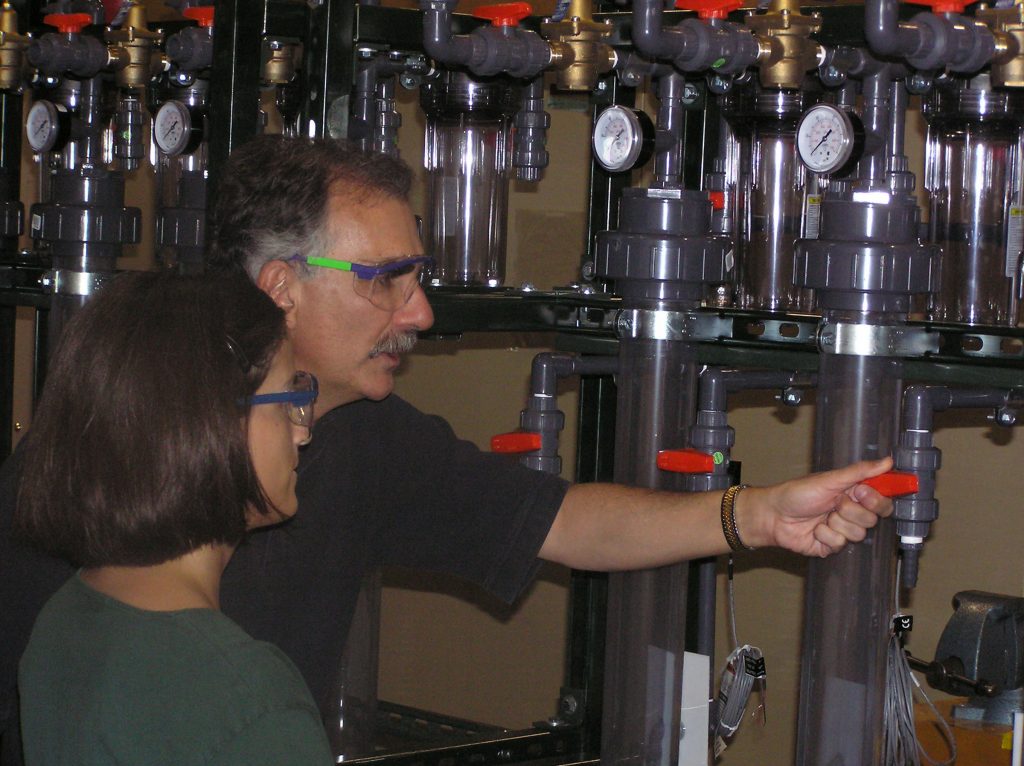
ALBUQUERQUE, N.M. — Over the next several months a team of researchers from the National Nuclear Security Administration’s Sandia National Laboratories will be studying different methods of arsenic removal at the Desert Sands Mutual Domestic Water Consumers Association (MDWCA) in Anthony in southern New Mexico.
The research is sponsored by the Arsenic Water Technology Partnership, a consortium of Sandia; the Awwa Research Foundation (AwwaRF); and WERC, A Consortium for Environmental Education and Technology Development. U.S. Sen. Pete Domenici, R-N.M., secured the funding for the project through the U.S. Department of Energy (DOE) as chairman of the Senate Energy and Water Development Appropriations Subcommittee. At the ceremony on Friday, Aug. 26, Sandia and the MDWCA will sign a memorandum of understanding (MOU) to begin the research.
Pilot test ‘lift-off’ ceremony set
A ceremony marking the start of the Desert Sands Mutual Domestic Water Consumers Association arsenic removal project is set for Friday, Aug. 26, at 10 a.m. at the main well site. On hand will be representatives from Sandia, Sen. Pete Domenici’s office, the State Legislature, and the water utility.
Directions to the well site
From the North, take I-25 to I-10 East ; take I-10 Vado exit, get on the frontage road (a.k.a. Stern Drive) and head south for 5 miles, turn right onto Hwy. 460 (a.k.a. Anthony Drive) then turn right on Shrode Road (the first paved street) continue west on Shrode about 1/2 mile. The pavement ends just past Berino Elementary School, continue about 150 yards on the dirt road and turn left into Well Site #3.
From the South, take I-10 West to O’Hara Road (a.k.a. Hwy. 404) exit, take O’Hara Rd. west to the stop sign, turn right onto Hwy. 460 (a.k.a. Anthony Drive), after about 2 miles turn left onto Shrode Road, continue west on Shrode about 1/2 mile and about 150 yards past the end of the pavement, turn left into Well Site #3.
News media: Please RSVP to 505-844-0948 by 2 p.m. Thursday, Aug. 25, if you plan to attend.
“The Desert Sands project will supplement a full-scale demonstration by the U.S. EPA [Environmental Protection Agency] for evaluation of a removal technology that uses granular iron oxide to filter arsenic from water,” says Malcolm Siegel, Sandia project manager. “As water is pumped through the system, arsenic sticks to the iron oxide. The Desert Sands MDWCA wants Sandia to compare the performance of the [iron oxide] material they are currently using to other adsorptive media. We should be able to give them some practical advice based on what we learn.”
The Sandia field team includes lead engineer Malynda Aragon and field technicians Randy Everett and William Holub. Aragon anticipates they will test between eight and 12 different arsenic removal systems at the Anthony site. “We’ll be looking at which material best adsorbs arsenic to compare how often the adsorptive media needs to be changed,” she says.
The treatment system, including plastic columns filled with adsorptive material and monitoring equipment, was built at Sandia and was recently relocated to the Desert Sands utility.
Desert Sands serves a population of 1,535 from two wells in a rural community along the New Mexico-Texas state line, north of El Paso. It has a new water treatment plant built by Severn Trent Corp. that uses the iron oxide treatment method.
The Anthony research is a follow-up to work in Socorro where the Sandia team tested five arsenic removal technologies at a geothermal spring. The pilot test in Socorro compared five technologies. These treatment processes were chosen from more than 20 candidate technologies that were reviewed by teams of technical experts at Arsenic Treatment Technology Vendor Forums organized by Sandia and held at the 2003 and 2004 New Mexico Environmental Health Conferences.
Congressional support and design of the Arsenic Water Technology Partnership was developed under the leadership of Domenici to help small communities comply with the new EPA drinking water standard for arsenic. The new regulation, which will go into effect in January 2006, reduces the Maximum Contaminant Level (MCL) from 50 micrograms per liter (µg/L) to 10 µg/L and is designed to reduce the incidence of bladder and lung cancers caused by exposure to arsenic.
Levels of naturally occurring arsenic in the Southwest U.S. often exceed the new MCL. The new compliance requirements will affect small communities that lack the appropriate treatment infrastructure and funding to reduce arsenic to such levels.
Siegel says that the goals of the program are to “develop, demonstrate, and disseminate information about cost-effective water treatment technologies in order to help Native Americans and small communities in the Southwest and other parts of the country comply with the new EPA standard.”
Besides the Socorro and Desert Sands experiments, additional demonstrations, based on technologies reviewed at vendor forums and developed by DOE labs or in laboratory studies managed by AwwaRF, are also being considered in consultation with the New Mexico Environment Department, the EPA, the Indian Health Service, the Navajo Nation EPA, and the Interstate Technology Regulatory Council.
WERC, a consortium of research institutions in New Mexico, will evaluate the economic feasibility of the technologies, work on technology transfer activities, and conduct educational outreach.
Whether a current proposal to phase in stricter arsenic requirements over years takes hold or not, there will still be a need to help communities modify systems to perform better, says Siegel. Scientists are also beginning to look at other contaminants that may be regulated in the future. “We need to stay ahead of the curve so communities can invest in proven systems that will address multiple contaminants,” he says.